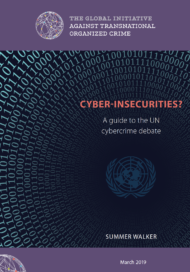The UN should follow the secretary general’s lead on artificial intelligence and cybercrime.
There is no doubt that artificial intelligence is rapidly becoming part of everyday life. In the public sphere, the authorities are increasingly using facial-recognition technology to identify people; in our private lives, mapping and translation apps are now commonplace; and machine learning is applied in fields as diverse as conservation, healthcare and food cultivation.
As AI becomes more powerful and wide-reaching, many at the international level are debating the dual nature of AI technology – in other words, its potential to beneficially transform society and foster development, while also introducing new risks to global security.
At the UN, AI and the Fourth Industrial Revolution are among Secretary General Guterres’s 2018 key priorities. He has proposed capitalizing on the UN’s role as an international forum to push forward discussions on the topic among member states, the private sector, scientists and civil society. Conversations about AI have been initiated in a number of important areas, including disarmament and development.
In terms of the potential beneficial applications of AI for development – particularly in relation to Agenda 2030 – there has been some momentum. In May, the UN’s International Telecommunications Union (ITU) hosted its second AI for Good Global Summit, which focused on AI applications to advance the Sustainable Development Goals. Related to this, the ITU published a special journal on the potential positive contributions of AI. The UN’s Chief Executives Board, the organization’s highest-level coordination body, is also working on AI. In April, its High-Level Committee on Programs approved a process to improve UN engagement on AI capacity building related to Agenda 2030 and asked the ITU to draft a system-wide framework for this.
Regarding disarmament, the secretary general’s recently published agenda includes sections on cyberspace and artificial intelligence, raising concerns that game-changing technologies are emerging with greater frequency than ever before, and that their autonomous attributes have the ability to lower the threshold of use of force (as customarily understood in the UN charter and international law more widely). He also warns that the pervasiveness of these technologies could increase the risks, range and impacts of attacks, including those by non-state actors. Guterres encourages states to coordinate without delay if they hope to have a preventative impact. One state-led body working on this is the Group of Governmental Experts on emerging technologies in the area of lethal autonomous weapons systems within the Convention on Certain Conventional Weapons framework.
Cybercrime: The growing threat from AI
The secretary general has also raised the issue within the UN’s crime corridors. At the annual meeting of the Commission on Crime Prevention and Criminal Justice (CCPCJ), Guterres drew attention to how AI – and other new technologies associated with the Fourth Industrial Revolution – has the potential to create new forms of crime. However, the recent reports from this meeting and the expert group on cybercrime do not address AI, suggesting the issue has not yet made it into the state-led UN cybercrime discussions. Indeed, the potential impact of AI on cybercrime is one area where attention to the subject has arguably not kept pace with the potential threat.
There are, of course, some UN crime-related entities working on AI. In 2017, its Interregional Crime and Justice Research Institute (UNICRI) established a Centre for Artificial Intelligence and Robotics. Its objective is to educate policymakers on the risks and benefits of AI and robotics to inform policymaking. It recently held a meeting with INTERPOL where cybercrime was part of a larger discussion about the risks posed by criminal use of AI and potential responses using AI technology. Generally, though, the issue seems not to have gained the same momentum in the cybercrime sphere as it has in development and disarmament circles.
Yet current trends suggest that AI should assume a more central role in cybercrime discussions. Like its potential to have a positive transformative effect, AI also has the potential to transform how crime, and cybercrime in particular, is conducted. With AI, criminal actors will be able to hone their ability to carry out attacks and find new opportunities for attacks, such as altering the signalling system in driverless cars. AI could automate time-consuming tasks, such as spear phishing, to reach a larger target audience more quickly. Physical security could be at risk by creating or hacking automated weapons systems. And, as more personal data is collected and sifted by means of algorithms, criminal actors will have new ways to corrupt political processes or extort individuals based on their personal data.
The increasing pervasiveness of the Internet of Things (IoT) adds to the potential for new, possibly more personal, forms of cybercrime. Key trends in cybercrime identified by the chief of the UNODC’s Global Cybercrime Program include increased use of IoT in cybercrime and ransomware attacks, both of which could be enhanced through AI technologies.
The proprietary nature of AI is also changing, with more open-source coding and training available to a growing number of users – examples being Google’s open-source machine learning initiative, TensorFlow, and the Shenzhen Open Innovation Lab. While these advances offer potential benefits in many developing contexts, from food cultivation to healthcare systems, they also need to be considered in light of the risk of criminal activity. Such developments could provide criminal actors with easier access to AI tools, while making it more difficult to regulate how AI is used.
There are also potential positive applications for AI in addressing cybercrime. AI could increase the reach for detecting and defending against cyber attacks, some of which have had global reach. At one point, Google claimed it stopped 99% of incoming spam using its machine learning technology. Some also believe AI could become a useful tool to help attribute attacks to perpetrators – whether a criminal act carried out by an individual or a security breach by another state.
In many ways, AI has become a constant in many people’s lives, yet it remains somewhat of a mystery how it might impact policy areas. This ambiguity has not stopped UN members from engaging in debates on the subject in areas such as development and disarmament. As cybercrime discussions progress within the UN, paying attention to AI’s potential as a criminal tool could help states better understand and respond to the potential consequences.
¿Puede la ONU seguirle el ritmo al lado oscuro de la Inteligencia Artificial?
La ONU debería seguir los pasos señalados por del secretario general en materia de inteligencia artificial y ciberdelincuencia.
Sin dudas, la inteligencia artificial se está convirtiendo rápidamente en parte de nuestra vida diaria. En la esfera pública, las autoridades emplean cada vez con más frecuencia las tecnologías de reconocimiento facial para identificar personas; en nuestra vida privada, utilizamos ampliamente aplicaciones de mapas y de traducciones, y el aprendizaje automático – o Machine Learning – se aplica en campos tan diversos como la conservación, la salud, y el cultivo de alimentos.
A medida que la Inteligencia Artificial (IA) cobra fuerza y gana en alcance, muchos en la comunidad internacional están debatiendo su naturaleza dual – su potencial para transformar positivamente la sociedad e impulsar el desarrollo y, a la vez, el de plantear nuevos peligros sobre la seguridad mundial.
Dentro de la ONU, la IA y la Cuarta Revolución Industrial están entre las principales prioridades expuestas por el Secretario General António Guterres en 2018, quien propuso capitalizar el rol de la ONU como foro internacional y avanzar así en la discusión sobre este tema entre los Estados miembros, el sector privado, científicos y la sociedad civil. Al respecto, se han iniciado conversaciones sobre la IA en un número de áreas importantes, como el desarme y el desarrollo.
El beneficio potencial que puede tener la IA para el desarrollo, particularmente en relación a la Agenda 2030, ha generado cierto impulso. En mayo, la Unión Internacional de Telecomunicaciones de la ONU (UIT) presentó su segunda Cumbre Mundial “AI for Good”, la cual hizo foco sobre las aplicaciones de la IA que pueden facilitar el cumplimiento de los Objetivos de Desarrollo Sostenible. En este sentido, la UIT publicó la primera edición de un informe especial sobre las contribuciones potencialmente positivas de la IA. La Junta de los Jefes Ejecutivos del Sistema de las Naciones Unidas para la Coordinación – el principal foro de coordinación de la organización – también se encuentra trabajando sobre este asunto. En abril, su Comité de Alto Nivel sobre Programas aprobó un proceso destinado a mejorar la participación de la ONU en la construcción de capacidad en torno a la IA en relación con la Agenda 2030 y solicitó a la UIT la elaboración de un marco que involucre a todo el sistema.
Con respecto al desarme, la agenda publicada recientemente por el secretario general incluye secciones dedicadas al ciber espacio y la inteligencia artificial, elevando el nivel de preocupación sobre el ritmo de surgimiento de tecnologías disruptivas, cuyos atributos autónomos tienen la capacidad de bajar el umbral de empleo de la fuerza (como se lo entiende tradicionalmente en la ONU y más ampliamente en el derecho internacional). Advierte también que el uso generalizado de estas tecnologías podría elevar los riesgos, el alcance y los impactos de ataques, incluyendo aquellos de actores no estatales. Guterres señala que, si lo que se espera es un impacto preventivo, los Estados deben comenzar a trabajar coordinadamente sin demoras. Un organismo de dirección estatal que trabaja sobre este asunto es el Grupo de Expertos Gubernamentales sobre tecnologías emergentes en el area de sistemas de armas letales autónomas dentro del marco del Convenio sobre Ciertas Armas Convencionales.
Ciberdelincuencia: la creciente amenaza de la IA
El secretario general también ha planteado esta cuestión dentro de los pasillos de la ONU. En la reunión anual de la Comisión sobre Prevención del Delito y Justicia Penal (CCPCJ), Guterres hizo notar cómo la IA – y otras nuevas tecnologías asociadas con la Cuarta Revolución Industrial – puede dar lugar a nuevos tipos de delitos. A pesar de ello, los informes recientes que se desprenden de esta reunión y del grupo de expertos en delincuencia informática no abordan este asunto, lo que sugiere que la IA no ha llegado a la mesa de los debates sobre ciberdelitos liderados por los Estados. De hecho, puede decirse que la atención sobre el impacto potencial que puede significar la IA sobre la ciberdelincuencia no avanza al mismo ritmo que la amenaza que plantea.
Claro que algunos órganos de la ONU relacionadas con la delincuencia ya se encuentran trabajando sobre la IA. En 2017, el Instituto interregional de la ONU para Investigaciones sobre la Delincuencia y la Justicia (UNICRI) creó un centro para el monitoreo de la Inteligencia Artificial y la robótica, con el objetivo de educar a los formuladores de políticas sobre los riesgos y beneficios de ambas tecnologías. Recientemente, celebró un encuentro junto con INTERPOL en donde se discutió sobre ciberdelincuencia como parte de una discusión más amplia en torno a los riesgos que representa el uso criminal de la IA y las posibles repuestas que pueden darse de la mano de la ella. Sin embargo, a nivel general, el asunto parece no tener el mismo impulso en la esfera de la ciberdelincuencia como lo ha hecho en los círculos del desarrollo y el desarme.
Sin embargo, las tendencias actuales indican que la IA debería tener un rol más central en los foros sobre ciberdelincuencia. Del mismo modo que puede generar efectos transformadores positivos, la IA también tiene el potencial de trasformar cómo se llevan a cabo los delitos, particularmente los informáticos. Con la IA, los actores criminales podrán pulir sus habilidades al momento de atacar y encontrar nuevas oportunidades para hacerlo, por ejemplo, alterando el sistema de señalamiento de los vehículos autónomos. La IA podría automatizar tareas que consumen mucho tiempo, como el fraude o phishing sobre objetivos específicos, y llegar más rápido a la audiencia deseada. Además, conforme los algoritmos permitan reunir y seleccionar más información personal, los actores criminales tendrán nuevas formas de corromper procesos políticos o extorsionar a individuos en base a sus datos personales.
La presencia cada vez mayor de la Internet de las Cosas (IoT) eleva el potencial de que surjan nuevas formas de ciberdelincuencia, posiblemente más personales. Las principales tendencias en ciberdelincuencia identificadas por el director del Programa Mundial sobre Ciberdelincuencia de la UNODC incluye un aumento en el empleo de la IoT para cometer ciberdelitos y ataques cibernéticos, los cuales pueden ser fortalecidos mediante la IA.
La naturaleza privada de la IA también está cambiando, con mayor disponibilidad y capacitación en el desarrollo de softwares de código abierto y para un número mayor de usuarios – como las plataformas de aprendizaje automático con código abierto de Google, TensorFlow, y el Shenzhen Open Innovation Lab. Si bien estos avances brindan potenciales beneficios en muchos contextos de desarrollo, desde el cultivo de alimentos hasta los sistemas de salud, también se los debe tener en cuenta a la luz de los riesgos asociados con la actividad delictiva. Este tipo de avances podría darle la oportunidad a los actores criminales de acceder fácilmente a herramientas de IA, a la vez que haría más difícil regular el modo en el que se la utiliza.
La IA también podría emplearse positivamente en el abordaje de la ciberdelincuencia, ya que podría aumentar el alcance de detección y el nivel de defensa contra ataques cibernéticos, algunos de los cuales han tenido dimensiones globales. En un punto, Google afirmó que detuvo el 99% de los correos basura empleando su tecnología de aprendizaje automático. Algunos también creen que la IA podría ser una herramienta útil para ayudar a encontrar a los perpetradores – ya sea de actos delictivos llevados a cabo por un individuo, o bien se trate de una violación a la seguridad cometida por otro Estado.
De muchas maneras, la IA se ha vuelto una constante en la vida de muchas personas. Aun así, no tenemos la certeza sobre cómo puede influir en el área de políticas. Esta ambigüedad no ha detenido a los miembros de la ONU, los cuales han debatido el asunto en áreas como el desarrollo y el desarme. A medida que avanzan las discusiones sobre ciberdelincuencia dentro del ámbito de la ONU, prestarle atención al potencial de la IA como herramienta delictiva podría ayudar a los Estados a comprender y responder mejor a las posibles consecuencias.



